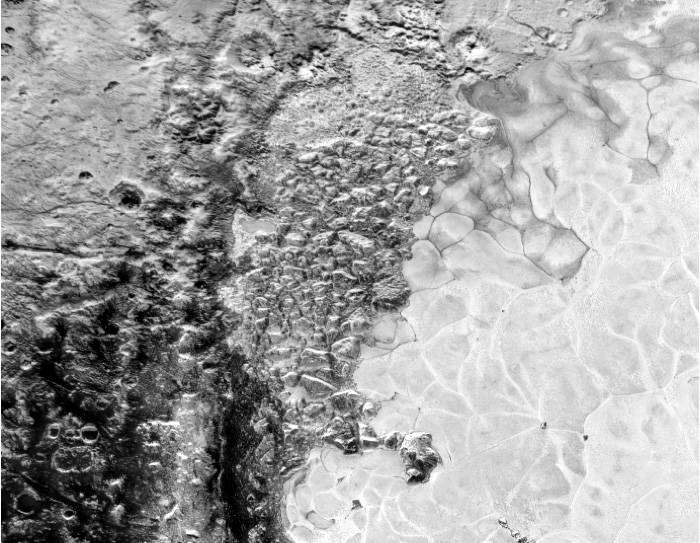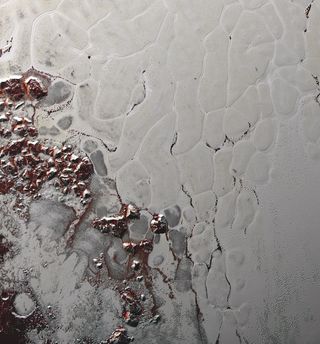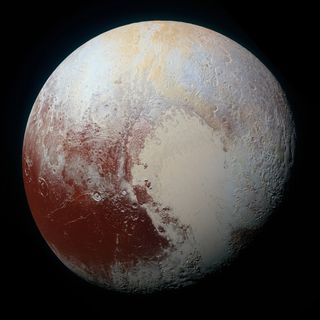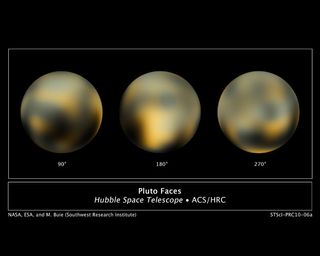Weird Shapes on Pluto Hint at Icy 'Face-Lift' Over Time

Strange geometric shapes miles wide seen on Pluto's icy surface likely formed because of a churning sheet of frozen nitrogen more than a half-mile thick, two new studies find. The findings reinforce the idea that Pluto is not cold and dead but surprisingly geologically active, the researchers say.
The findings could shed light on how other icy dwarf planets far beyond Pluto in the solar system might behave, the researchers added.
Scientists analyzed the most prominent geological feature on Pluto — a vast, oval-shaped basin informally named Sputnik Planum. The area, which stretches across Pluto's equator, is about 347,500 square miles (900,000 square kilometers) and at least 1.2 to 1.8 miles (2 to 3 km) deep. Its shape and surrounding mountains suggest it is a crater left over from a giant cosmic impact "maybe 4 billion or more years ago," said William McKinnon, a planetary geophysicist at Washington University in St. Louis and lead author of one of the two studies analyzing Pluto. [See the Amazing Pluto Pictures by New Horizons]

The mystery of Pluto's polygons
Sputnik Planum is filled with ice made up predominantly of nitrogen. This frozen nitrogen is broken up into odd, irregular polygons about 6 to 25 miles (10 to 40 km) across, and the centers of some of these polygons rise about 165 feet (50 meters) above their sides.
To discover the origins ofthese mysterious polygons, which the researchers also called "cells," the scientists analyzed data from NASA's New Horizons spacecrraft, which made the first-ever flyby of Pluto in July 2015. Their computer models suggest that convection, or churning that arises from the rising and sinking of warmer and cooler matter, could help explain the giant sizes of these cells. (Pluto's innards are warmer than its surface because of heat from long-lived radioactive material.)

Specifically, the research team's models suggest that layers of nitrogen ice more than 0.6 miles (1 km) thick are convecting to create these cells. "The convection you're seeing here is unlike anything seen before in the solar system, because the material that's convecting isn't rigid and strong — everything here is softer," McKinnon told Space.com. "Nitrogen ice is not soft like a gummy bear is soft, but still more pliable than water ice on Earth, so it's convecting vigorously and forming these polygonal cells."
A face-lift for Pluto
The scientists estimated that convection likely leads the surface of Sputnik Planum to renew itself about every half-million years. This makes it one of the youngest surfaces in the solar system.
Get the Space.com Newsletter
Breaking space news, the latest updates on rocket launches, skywatching events and more!
McKinnon noted that in the past, "Pluto's internal heat flow would have been higher, so the convection would have been even more vigorous, and could even have led to melting of the solid nitrogen at depth, which, by being buoyant, would have erupted as a very fluid 'lava.'"

The researchers suggested that similar convective processes may also occur at other dwarf planets, such as those in the Kuiper Belt, the shadowy disk-shaped region beyond the orbit of Neptune that scientists think is populated by a trillion or more comets as well as hundreds of thousands of icy moon-size objects. Such convection might help explain why some icy Kuiper Belt objects are as shiny as they are — such churning would continuously give them new faces of reflective ice relatively unmarred by craters and dust.
The scientists detailed their findings in two papers, one here and the other here, in the June 2 issue of the journal Nature.
Follow Charles Q. Choi on Twitter @cqchoi. Follow us @Spacedotcom, Facebook and Google+. Original article on Space.com.
Join our Space Forums to keep talking space on the latest missions, night sky and more! And if you have a news tip, correction or comment, let us know at: community@space.com.

Charles Q. Choi is a contributing writer for Space.com and Live Science. He covers all things human origins and astronomy as well as physics, animals and general science topics. Charles has a Master of Arts degree from the University of Missouri-Columbia, School of Journalism and a Bachelor of Arts degree from the University of South Florida. Charles has visited every continent on Earth, drinking rancid yak butter tea in Lhasa, snorkeling with sea lions in the Galapagos and even climbing an iceberg in Antarctica. Visit him at http://www.sciwriter.us